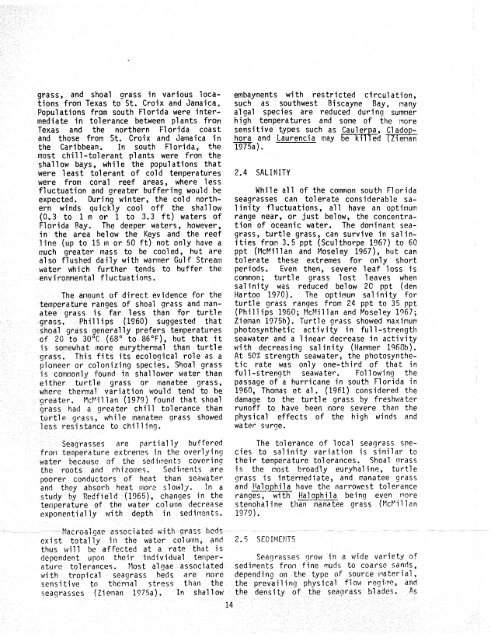The Ecology of the Seagrasses of South Florida - USGS National ...
The Ecology of the Seagrasses of South Florida - USGS National ...
The Ecology of the Seagrasses of South Florida - USGS National ...
Create successful ePaper yourself
Turn your PDF publications into a flip-book with our unique Google optimized e-Paper software.
grass, and shoal grass in various 10cations<br />
from Texas to St. Croix and Jamaica.<br />
embayments with restricted circulation,<br />
such as southwest Biscayne Bay, nany<br />
Populations from south <strong>Florida</strong> were inter- algal species are reduced during summer<br />
mediate in tolerance between plants from high temperatures and some <strong>of</strong> <strong>the</strong> nore<br />
Texas and <strong>the</strong> nor<strong>the</strong>rn <strong>Florida</strong> coast sensitive types such as Cauler a<br />
and those from St. Craix and Jamaica in hora and Laurencia nay d9F@=<br />
e ki ed Zienan<br />
<strong>the</strong> Caribbean. In south <strong>Florida</strong>, <strong>the</strong> 1975a).<br />
most chill-tolerant plants were from <strong>the</strong><br />
shallow bays, while <strong>the</strong> populations that<br />
were least tolerant <strong>of</strong> cold temperatures 2.4 SALINITY<br />
were from coral reef areas, where less<br />
fluctuation and greater buffering would be While all <strong>of</strong> <strong>the</strong> common south <strong>Florida</strong><br />
expected. During winter, <strong>the</strong> cold north- seagrasses can to1 erate considerable saern<br />
winds quickly cool <strong>of</strong>f <strong>the</strong> shallow linity fluctuations, all have an optimum<br />
(0.3 to 1 m or 1 to 3.3 ft) waters <strong>of</strong> range near, or just below, <strong>the</strong> concentra-<br />
<strong>Florida</strong> Fay. <strong>The</strong> deeper waters, however, tion <strong>of</strong> oceanic water. <strong>The</strong> dominant seain<br />
<strong>the</strong> area below <strong>the</strong> Keys and <strong>the</strong> reef grass, turtle grass, can survive in sal inline<br />
(up to 15 m or 50 ft) not only have a ities fron 3.5 ppt (Sculthorpe 1967) to 60<br />
much greater mass to be cooled, hut are ppt (McVillan and Moseley 1967), but can<br />
also flushed daily with warmer Gulf Strea~t tolerate <strong>the</strong>se extremes for only short<br />
water which fur<strong>the</strong>r tends to buffer <strong>the</strong> periods. Even <strong>the</strong>n, severe leaf loss is<br />
envi ronmental fluctuations. common; turtle grass lost leaves when<br />
sa1 inity was reduced below 2C ppt (den<br />
<strong>The</strong> anount <strong>of</strong> direct evidence for <strong>the</strong> Warton 1970). <strong>The</strong> optimuin sal ini ty for<br />
temperature ranges <strong>of</strong> shoal grass and man- turtle grass ranges from 24 ppt to 35 ppt<br />
atee grass is far less than for turtle<br />
grass, Phil 1 Ips (1960) suggested that<br />
(Phil1 ips 1960; HcMillan and Poseley 1Q67;<br />
Zieman 1975h). Turtle grass showed maxinum<br />
shoal grass generally prefers temperatures photosyn<strong>the</strong>tic activity in full -strength<br />
af 20 to 30°C (68' to 86aF), but that it seawater and a linear decrease in activity<br />
is somewhat marc ecrry<strong>the</strong>rmal than turtle ti th decreasing sal ini ty (Hammer lP68b).<br />
grass, This fits its ecological role as a At 5QX strength seawater, <strong>the</strong> photosyn<strong>the</strong>pioneer<br />
or colonizing species. Shoal grass tic rate was only one-third <strong>of</strong> that in<br />
is comnonly Found in shallower water than full-strength seawater. Fo1 lowing <strong>the</strong><br />
ei<strong>the</strong>r turtle grass ar manatee grass, passage <strong>of</strong> a hurricane in south <strong>Florida</strong> in<br />
wherc <strong>the</strong>n~al variation would tend to be 1960, Thornas et a1 . (1951) considered <strong>the</strong><br />
greater, FAcP"i1 lan (1979) found that shoal damage to <strong>the</strong> turtle grass hy freshwater<br />
grass had a greater chill tolerance than run<strong>of</strong>f to have been more severe than <strong>the</strong><br />
turll~ grass, while manatee grass showed<br />
less resistance to chi1 I ing,<br />
pl~ysical effects <strong>of</strong> <strong>the</strong> high winds and<br />
water surge.<br />
<strong>Seagrasses</strong> are partially huf'fercd <strong>The</strong> tolerance <strong>of</strong> local seagrass spefral<br />
tetnpcrdture extrelscs in <strong>the</strong> overlying cies to sal a'nity variation is simildr to<br />
water because <strong>of</strong> <strong>the</strong> scctir~en ts covcring <strong>the</strong>ir temperature to1 erances. Shoal Grass<br />
<strong>the</strong> roots and rhizotiles. Sedi~?cnts are is thc nost broadly euryhaline, turtle<br />
poorer conductors <strong>of</strong> heat than seawater grass is intermediate, and vanatee grass<br />
and <strong>the</strong>y absorb heat morc slowly. In a and - fJalophi1a -- have <strong>the</strong> narrowest tolerance<br />
study by Redfield (19651, changes in <strong>the</strong> ranges, with -- tialghila being even rqore<br />
ter:;perature <strong>of</strong> <strong>the</strong> water cel urnn decrease stenohal ine than manatee grass (F-?clJil 1 an<br />
exponent? at ly ni th depth in sedir??n ts. 1979).<br />
Hxtroa? ~ ae assaci;tcd wi kt? grass beds<br />
exist totally it? <strong>the</strong> water coluinn, and 2.5 5EDIYCP!TS<br />
thus will be af fccted at a rate thdt is<br />
dcpcndent upon <strong>the</strong>ir indivitlual tellper- Scagrassec qrow in a wide variety <strong>of</strong><br />
attlrc tolerances. Ilost algae associated sediments froir fine mud.; to coarse sands,<br />
with tropical seagrass beds are more depending on <strong>the</strong> type <strong>of</strong> source rf?ateriii'I,<br />
sensitive to t"n~7tii stress than <strong>the</strong> <strong>the</strong> prevailing physical flaw regi4n@, and<br />
.;@itgrasses (Zieman lQ75a). Ira shallow <strong>the</strong> density <strong>of</strong> <strong>the</strong> Seagrdss blad~s. AS<br />
14

















